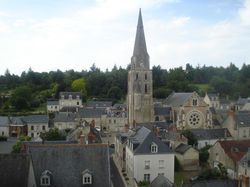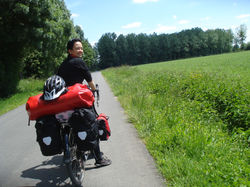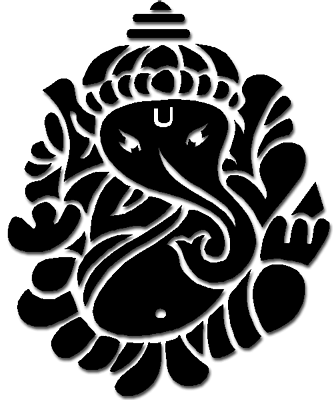
Julianna and CJ's ~ Follow Your Bliss








Bicycling across France - Eurovelo 6
1,255 km
France
Romania
The Loire Valley : St Nazaire to Saumur ~ 208 km
The Loire Valley : Saumur to Chinon ~ 100 km
Coming Soon
The Loire Valley : Chinon to Muides-sur-Loire ~ 142 km
 DSC01823.JPG |  IMAG1173.jpg |  IMAG1167.jpg |
|---|---|---|
 DSC01827.JPG |  DSC01809.JPG |  DSC01811 - Huismes.JPG |
 IMAG1162.jpg |  IMAG1172.jpg |  DSC01830.JPG |
 IMAG1154.jpg |  DSC01807.JPG |  DSC01812 - Camping Municipal - .JPG |
 IMAG1287.jpg |  IMAG1283.jpg |  IMAG1282.jpg |
 IMAG1281.jpg |  DSC01995.JPG |  IMAG1295.jpg |
 IMAG1294.jpg |  IMAG1293.jpg |  IMAG1286.jpg |
 IMAG1278.jpg |  IMAG1270.jpg |  IMAG1262.jpg |
 IMAG1260.jpg |  IMAG1259.jpg |  IMAG1254.jpg |
 IMAG1253.jpg |  IMAG1249.jpg |  IMAG1239.jpg |
 IMAG1231.jpg |  IMAG1218.jpg |  IMAG1217.jpg |
 IMAG1197.jpg |  IMAG1215.jpg |  IMAG1275.jpg |
 IMAG1201.jpg |  IMAG1182.jpg |  DSC02020.JPG |
 DSC02012.JPG |  DSC02011.JPG |  DSC01998.JPG |
 DSC01994.JPG |  DSC01991.JPG |  DSC01959.JPG |
 DSC01951.JPG |  DSC01947.JPG |  DSC01940.JPG |
 IMAG1284.jpg |  DSC02016.JPG |  DSC02005.JPG |
 IMAG1279.jpg |  DSC02000.JPG |  DSC01838.JPG |
 DSC01931.JPG |  DSC01945.JPG |  DSC01835.JPG |
 DSC01997.JPG |  DSC01982.JPG |  DSC01958.JPG |
 IMAG1268.jpg |  DSC02007.JPG |  IMAG1265.jpg |
 DSC01837.JPG |  DSC01952.JPG |  DSC02018.JPG |
 IMAG1296.jpg |  DSC02017.JPG |  IMAG1179.jpg |
The Loire Valley : Chambord Castle
Muides-sur-Loire to Sully-sur-Loire ~ 177 km
Sully-sur-Loire to Bourbon Lancy ~ 238 km
Bourbon-Lancy to Seurre ~ 211 km
Seurre to Mulhouse ~ 157 km
With its 128 metres of façades, 440 rooms and 282 chimneys, the Château de Chambord is the largest of the castles in the Loire Valley. A former hunting ground of the Counts of Blois, the château nestles in the heart of a 5500 hectare park (4500 hectares of which is given over to woodland which is now a national hunting reserve. Its refined Renaissance façades contrast with the profusion of tiny windows, chimneys, spires and steeples that can be viewed at leisure from the stunning Italian-style terrace.
 Our starting point: Saint NazaireWe arrived to Saint Nazaire on the French Atlantic Coast by train on May 25th 3013. We then took a bus to cross the spectacular though hazardous Saint Nazaire bridge over the Loire estuary to reach the seaside resort of Saint-Brévin-les-Pins. Once there, we pedaled onto our campsite, camping Mindin for the night, set up camp and got settled for our 1st night camping in France. |  Saint Nazaire's train Station |  Direction EastThe next day, May 26th 2013, we officially started our trip, and on we went traveling East. Our 1st stop was Paimboeuf, only 18 km away, but for us for our 1st day ever bicycle touring and having not trained for this adventure, we thought it would be plenty, and indeed, it was :) |
|---|---|---|
 Saint Nazaire's Bridge |  |  |
 Paimboeuf's streetsWe stopped for the night in Paimboeuf at the camping l'Estuaire and went on through the town the next day onto our next destination |  |  |
 |  |  23 km onto our adventureGPS Garmin |
 |  Le Migron |  Camping Municipal MigronOur next campsite was at Le Migron. We got heavy rains all night and a very cold night and morning |
 Ferrie at Le PellerinLe Pellerin is a lovely French village a few kilometres west of the city of Nantes on the south bank of the Loire in the Loire-Atlantique, there the free RORO ferry operates to carry people and vehicles across the river. On we went on the ferry and crossed to the Loire |  Rain here you are!Throughout May and June we got rain after rain and cold temperatures. The sun showed up in July and we welcomed it! |  The house in the LoireLa Maison dans la Loire de Jean-Luc Courcoult is piece of art presented to the art expo of l'Estuaire - Nantes in 2007. It sits in the Loire and it is fun to see. It is situated in Coueron |
 |  |  Getting into Nantes |
 NantesNantes was the 1st major city we bicycled through with our bikes. Nantes is located on the Loire River and it is the 6th largest city in France. |  Battleships in Nantes |  Our Lunch spot |
 Belle Riviere CampingAfter passing through Nantes, we chose to stop in a lovely campsite along the Loire river in the small town of Saint Luce-sur-Loire. We enjoyed the place and took a day break to get some laundry done |  Vineyards along the LoireLooking at Oudon and its Tour from above |  La tour d'OudonLa tour dates from the 14th century |
 |  La tour d'Oudon |  |
 |  Oudon Municipal Camping |  DSC01125.JPG |
 Pasta diner |  Bouzille Camping |  Sunset on the Loire |
 Our bicycle Path |  Chalonnes-sur-Loire |  |
 |  |  |
 |  |  Le chateau d'Ancenis |
 Ancenis |  |  |
 |  |  |
 DSC01173.JPG |  Time for lunch |  |
 St Floren Le Veil |  |  La Promenade Camping |
 Taboule for diner |  |  L'ile du Chateau CampingLes Ponts-de-Cé |
 DSC01198.JPG |  Les Ponts-de-Cé |  Port La Vallee Camping |
 |  Saint-Rémy-la-Varenne |  Le Prieuré de St Rémy la Varenne |
 Prieuré de St Rémy la Varenne |  Break TimeIn France, we loved taking break time to enjoy the sites and devour tasty pastries |  Miam!!!!So delicious these French bakeries |
 Passing through Gennes |  Digging through the bagsA usual daily routine...the digging through the bag quest |  Camping de ChantepieLovely 4 stars campsite on the outskirts of Saumur with camp sites reserved for touring cyclist. It's up a nice 1 km hill though... |
 Les vins de la LoireTasty Rose strapped to the back of our back pannier en route to our allotted campsite...Sante! |  Rose de la Loire |  Our spotOur nice and spacious spot at the Chantepie Campground |
 |  Way to La Loire Riviere |  Chantepie CampgroundThe camping was decorated with lovely flowers |
 Chantepie CampgroundLovely farm pig |  Chantepie CampgroundThe campsite had a lovely farm |  Vineyards along the route leading into Saumur |
 SaumurSplendid view of the city of Saumur and its castle. We spend a couple days in this beautiful city. We took some time to visit the underground wine cellar of Louis de Grenelle and the lovely castle. |  Julianna over looking SaumurThe view of the overlooking Château |  Les Caves de Louis De GrenelleSince Saumur is world famous for its wine, we decided to take a tour of the only cellar (cave) that locates itself right underneath the city - Les Caves de Louis De Grenelle. In the heart of the Loire Valley, the Louis de Grenelle house develops fine sparkling wines : Crémant de Loire, Saumur Rosé and Saumur Brut. Created in 1859, it remains the last independent and family owned sparkling wine house |
 The EntranceThe tour took us 12 meters underground in former limestone quarries dug in the XVth century right underneath the city of Saumur |  The wine tanks |  |
 |  Storage of the winesIn 1859, quarries were converted into aging cellars for Louis De Grenelle' Saumur and Crémant de Loire sparkling wines. Due to the ventilations shafts, these huge underground cellars are at a constant temperature of 12 degrees all year long and a hygrometry of almost 80% which creates ideal storage condition for the maturation of the wines |  4 million bottlesToday, almost 4 million bottles slowly handle the second fermentation process in the caves |
 2.5 km of GalleriesThis fascinating labyrinth, made of 2.5 km of galleries, allowed us to walk through Saumur’s underground world. What a wonder to be able to walk under Saumur' streets |  Tasting CellarThe tour in the cellars ends up with the jewel : the underground tasting cellar |  The seat of the king |
 |  Time for a nice bottleWe enjoyed taking a bottle back with us at camp |  |
 Le Château de SaumurBuilt during on the XIVth century for the Ducs d’Anjou, the castle becomes the house of the governors of the town, then a jail, before being bought by the town in 1906 |  |  |
 Time to Visit our 1st CastleWe took some time to visit this magnificent castle along the Loire Valley, we enjoyed every minute of it. This was our first castle of many to come |  |  |
 Inside the Castle |  France's Monarchy |  |
 |  |  We loved SaumurWe camped at Saumur's municipal camping on the other bank of the Loire right across from the castle |

The Eurovelo 6 route from Saint-Nazaire to Besançon along the Loire and the Saone Rivers is the most famous and prestigious cycle tourist route in all of France. Two-thirds of the route passes through the Loire Valley, which has been listed as a World Heritage site by UNESCO. This part of the EuroVelo 6 route has many connections with royalty with an unbelievable number of castles, each one more magnificent than the previous. As the route follows the course of rivers, it is generally quite flat making it ideal cycling territory
Serbia
Coming Soon


































































